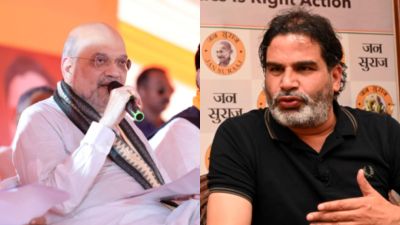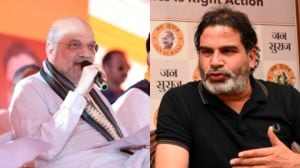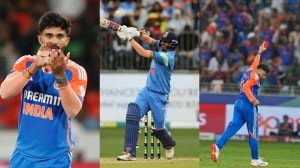Apart from the quota agitation and farmers’ distress, a highlight of the Gujarat elections so far has been Rahul Gandhi’s campaign in Saurashtra, and the impression it appears to have left on rivals and followers.
With a programme schedule that attempts to reach out to all sections, alongside a carefully crafted social media campaign, Rahul has sought to come across as an earnest political leader. His two-month campaign since September 25 have included a dozen public meetings, three dozen interactions with various groups, and dozens of corner meetings. He has spent 16 full days on the ground.

Often the target of ridicule from the BJP, Rahul has this time been under a sustained attack for his temple visits across Gujarat. This has been widely read as a sign that the BJP is taking him seriously.
Story continues below this ad
So are a number of voters in Saurashtra, for a number of reasons. “No one laughs at Rahul Gandhi or ridicules his speeches. We feel he has started talking sense,” said Bhavesh Patel, a young mechanic in Ahmedabad. Nimish Phadke, managing director of Federation of Kutch Industries Associations agreed. “This election may or may not be a turning point for his party, but there is no debate that it has given him a new avatar as an astute political leader,” Phadke said.
Also Read: Rahul Gandhi’s small meeting with fishermen aims big return for Congress
During his campaign, Rahul has struck a chord with many Patidars, who were upset at being “taken for granted” by the BJP. Other aspects that have impressed various voters include an image of Rahul hugging a part-time woman teacher after listening to her problems at an interactive session in Ahmedabad; his advice to young campaigners in Banaskantha that they should keep smiling and keep the campaign dignified; the warm welcome he got at Ambaji temple in Banskantha, in contrast to a lukewarm reception in 2014 there.
Vishal Motwani, a student in Ahmedabad, was impressed with Rahul’s restraint. “In Ambaji, Rahul told his party workers not to ridicule Prime Minister [Narendra] Modi. In Vadodara, he said would never want a ‘BJP-mukt Bharat’ because, he said, ‘both the Congress and the BJP have the ideology of Indians’,” Motwani said.
Story continues below this ad
The overall impression was created with a multi-pronged strategy, said those who work with him. “The primary focus was on improving his image among the urban class, so we organised interactions with different professionals — teachers, students, doctors, healthcare activists, traders — in various places,” said one of Rahul’s campaign planners. Groups in other interactions have included farmers, fishermen, tribals, ASHA and anganwadi workers, dairy farm owners and labourers, members of Mahila Milk Cooperatives and skilled workers. “We let voters criticise the Gujarat model rather than Rahul himself attacking it,” said the campaign planner. Another strategist added: “The idea was to present him as a credible leader who was ridiculed by the BJP.”
The planning has included optics. At Dalit Shakti Kendra in Ahmedabad’s Nani Devati village on November 25, Rahul accepted a 1259 ft ×83 ft tricolour, which had been reportedly presented to Chief Minister Vijay Rupani four months ago but was apparently turned down by officials. Photos of Rahul obliging selfie requests from children are circulating on social media and local newspapers.
In Porbandar, the Congress chose a small, open plot in front of the old office of the Gujarat Maritime Board, rather than the larger Chowpaty Ground. A Congress leader said the party has chosen smaller spots and corner meetings because it realises it meetings cannot match the flamboyance of BJP events organised for PM Modi. The leader said the party would “keep the momentum going” by sending 60 senior leaders in the last two weeks of the campaign
Optics also include the temple visits that have drawn such consistent attacks from the BJP leadership. Congress leaders agreed that this is a deliberate attempt at a “soft Hindutva line” as the party is confident that it will retain the minority vote. Rahul, who had kicked off his campaign from the Dwarkadhish temple in Dwarka, has visited temples of all major sects — Swaminarayan, Khodaldham, Umiya Mata and Bahuchara. He also had darshans at Veer Meghmaya temple, sacred to the members of the Dalit Vankar community, and climbed 1,000 steps to seek the blessings of Maa Chamunda in Chotila, and declared himself a devotee of Lord Shiva.
Story continues below this ad
Having formed an impression, voters still have questions. “What is the alternate narrative Rahul has to offer?” said Motwani, the Ahmedabad student. “The BJP’s development plank has proved a success, at least with the aspirational youth and the urban middle class. What is the development model Rahul has to offer?”
“He sounds sincere and genuine. But to us, he did not come across as an efficient leader,” added Basantiben Patel, a homemaker who occasionally manages her husband’s grocery shop in Anand. And Devubhai Patel, a small trader in Amreli, noted: “You never see the Congress after an election. If Rahul and the Congress had worked so hard for a year, the party could have made inroads.”
Industrialist Phadke, on the other hand, said: “People who disagree with the Gujarat model may find a ray of hope in Rahul as an emerging political leader.”

 Gujarat elections: A young girl takes a selfie with Congress vice-president Rahul Gandhi during one of his road shows. PTI Photo
Gujarat elections: A young girl takes a selfie with Congress vice-president Rahul Gandhi during one of his road shows. PTI Photo 






























